

Research. DigitalLiteracies.pdf. Students and digital literacy. Using Technology to Enhance Literacy Instruction. This Critical Issue was coauthored by Ann Holum, Ph.D., and Jan Gahala, M.A.

Holum's doctoral work on the use of interactive media to improve children's story-understanding skills sparked her ongoing interest in integrating technologies in K-12 literacy settings; she currently is an independent educational consultant. Gahala is a technical specialist in NCREL's Communications department. ISSUE: Educational technology is nudging literacy instruction beyond its oral and print-based tradition to embrace online and electronic texts as well as multimedia. Computers are creating new opportunities for writing and collaborating. The Internet is constructing global bridges for students to communicate, underscoring the need for rock-solid reading and writing skills. Although technology promises new ways to promote literacy, educators' reactions to it have been mixed. Overview | Goals | Action Options | Pitfalls | Different Viewpoints | Cases | Contacts | References Edyth E. Audiobooks. On teaching, reading, writing, and technology.
Digital natives & immigrants. OR: Digital natives or immigrants? Can we please move on? Photo by Nico Cavallotto Times they are a-changing. Nothing new there. What is also changing are our characterisations of people who use the Internet. In the beginning (or near it) there was Mark Prensky. But it turned out that not everybody born before 1980 was an intractable technophobe. By 2009 Prensky himself was offering an alternative to the native/digital divide, and describing the emergence of ´homo sapiens digital´. Polemics aside, what does the characterisation of Internet users as digital natives/immigrants mean to those of us who are online educators? Digital Literacy. Digital divide and social media: Connectivity doesn’t end the digital divide, skills do. Whether we like it or not, we live in a very unequal and stratified world.

We live in societies in which inequality is ignored in education, science, and in the social media. As Internet technologies are rapidly evolving and new digital divides on the Internet emerge, we must move beyond, at some point, a singular concern over Internet access and technological infrastructure issues. We must tackle socio-cultural differences, we must focus on Internet skills, literacies and social media usage.
Recently I finished a study on social inequalities from an Internet perspective (to be published next year) where I examined moving beyond digital inequalities in the context of the technological infrastructure and Internet access. Previous experiences in the scientific, academic, governmental and commercial communities in the last decade and different practices of participatory and collaboration inequality made me curious about this shift. Digital Literacy. Home. Digital literacy campaign – we need your help. Starting this afternoon and running all this week, the Guardian will be launching a new campaign to improve the teaching of computer science and information technology in schools and universities – and we need your help.
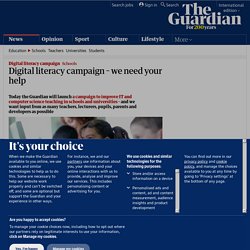
Tomorrow, Wednesday and Thursday we will be running live Q&As with teachers, lecturers and experts from technology companies such as Google and Microsoft. The first Q&A will take place tomorrow from 12-2pm featuring Steve Beswick of Microsoft and Martin Harvey of e-skills UK – click here from tomorrow morning to read it and take part. We want teachers, students, lecturers, developers and IT professionals to give their views on the teaching of IT and computer science. Information fluency model.
Digital Information Fluency (DIF) is the ability to find, evaluate and use digital information effectively, efficiently and ethically.
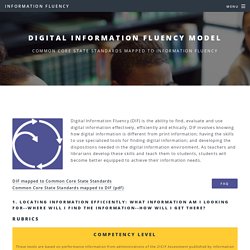
DIF involves knowing how digital information is different from print information; having the skills to use specialized tools for finding digital information; and developing the dispositions needed in the digital information environment. As teachers and librarians develop these skills and teach them to students, students will become better equipped to achieve their information needs. FAQDIF mapped to Common Core State Standards Common Core State Standards mapped to DIF (pdf) 1. Locating Information Efficiently: What Information Am I Looking For--Where Will I Find the Information--How Will I Get There? Rubrics 2. 3. It could be argued that Competency in Ethical Use should be demonstrated by "always citing the source" and that anything less demonstrates incompetency. 4. Universities must rethink their approach to student digital literacy. It's all about the conversation: Mark Zuckerberg speaks at the Facebook f8 Developer Conference at the San Francisco Design Center.
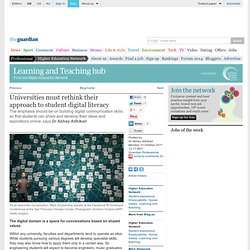
Photograph: Kimihiro Hoshino/AFP/Getty Images The digital domain is a space for conversations based on shared values Within any university, faculties and departments tend to operate as silos. While students pursuing various degrees will develop specialist skills, they may also know how to apply them only in a certain way. What digital literacies? Our digital natives are immigrating. Marc Prensky eloquently coined the metaphor of the “digital immigrant” to define an adult who has “immigrated” into the use of technology.
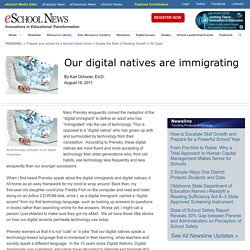
Open University research explodes myth of 'digital native' Gerald Haigh visits his alma mater to learn that a good attitude to technology correlates with good learning habits Is there a digital native?
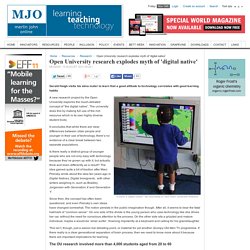
Not according to new Open University research A new research project by the Open University explores the much-debated concept of “the digital native”. The university does this by making full use of the rich resource which is its own highly diverse student body. It concludes that while there are clear differences between older people and younger in their use of technology, there’s no evidence of a clear break between two separate populations. Is there really a distinct group of younger people who are not only easy with technology because they’ve grown up with it, but actually think and learn differently as a result? Since then, the concept has often been questioned, and even Prensky’s own ideas have changed somewhat. This isn’t, though, just a saloon bar debating point, or material for yet another Grumpy Old Men TV programme. Digitalliteracypaper. Digital literacy « Coherence of the inchoate.